1998 CADILLAC ELDORADO instrument panel
[x] Cancel search: instrument panelPage 30 of 380
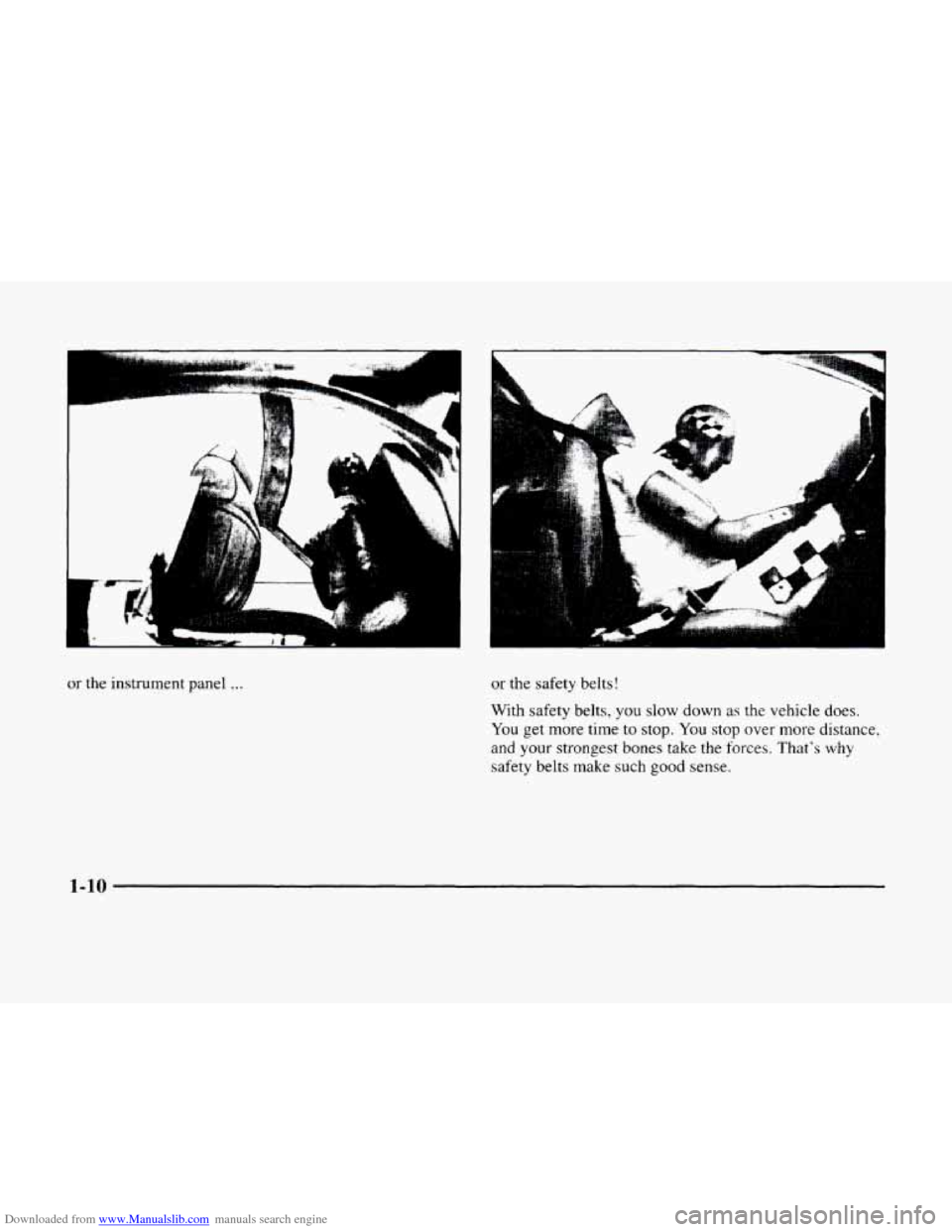
Downloaded from www.Manualslib.com manuals search engine or the instrument panel ... or the safety belts!
With safety belts,
you slow down as the vehicle does.
You get more time to stop. You stop over more distance,
and
your strongest bones take the forces. That's why
safety belts make
such good sense.
1-10
Page 41 of 380
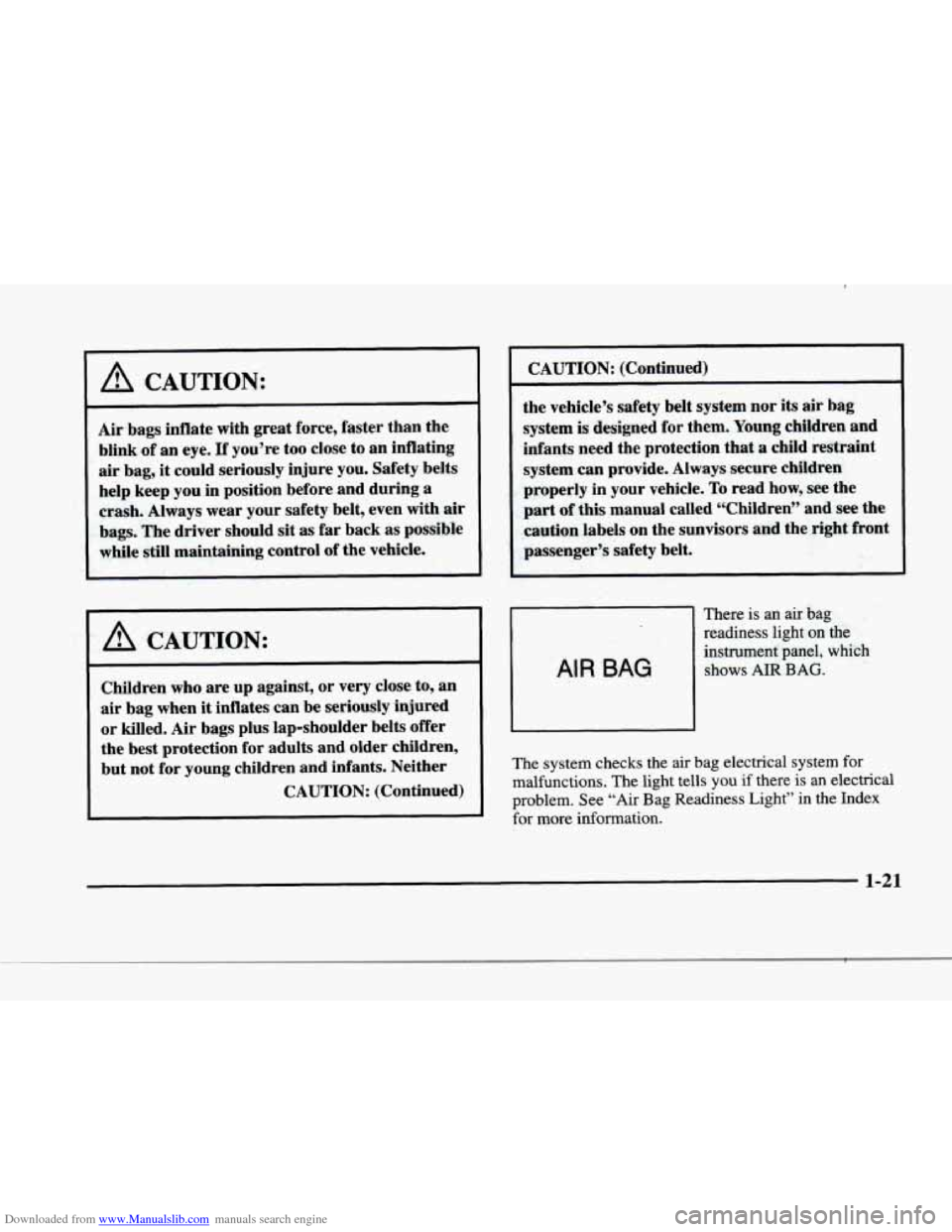
Downloaded from www.Manualslib.com manuals search engine r
r !
r
r
r
r
f- t
i
A CAUTION:
Air bags inflate with great force, faster than the
blink
of an eye. If you’re too close to an inflating
air bag, it could seriously injure you. Safety belts
help keep you in position before and during a
crash. Always wear your safety belt, even with
air
bags. The driver should sit as far back as possible
while
still maintaining control of the vehicle.
A CAUTION:
Children who are up against, or very close to, an
air bag when it inflates can be seriously injured
or killed. Air bags plus lap-shoulder belts offer
the best protection for adults and older children,
but not for young children and infants. Neither
CAUTION: (Continued) CAUTION: (Continued)
the vehicle’s safety belt system
nor its air bag
system
is designed for them. Young children and
infants need the protection that
a child restraint
system can provide. Always secure children
properly in your vehicle. To read how, see the
part of this manual called “Children” and see the
caution labels
on the sunvisors and the right front
passenger’s safety belt.
There is an air bag
readiness light on the
instrument panel, which
shows AlR BAG.
The system checks the air bag electrical system for
malfunctions. The light tells you if there is an electrical
problem. See “Air Bag Readiness Light” in
the Index
for more information.
1-21
Page 42 of 380
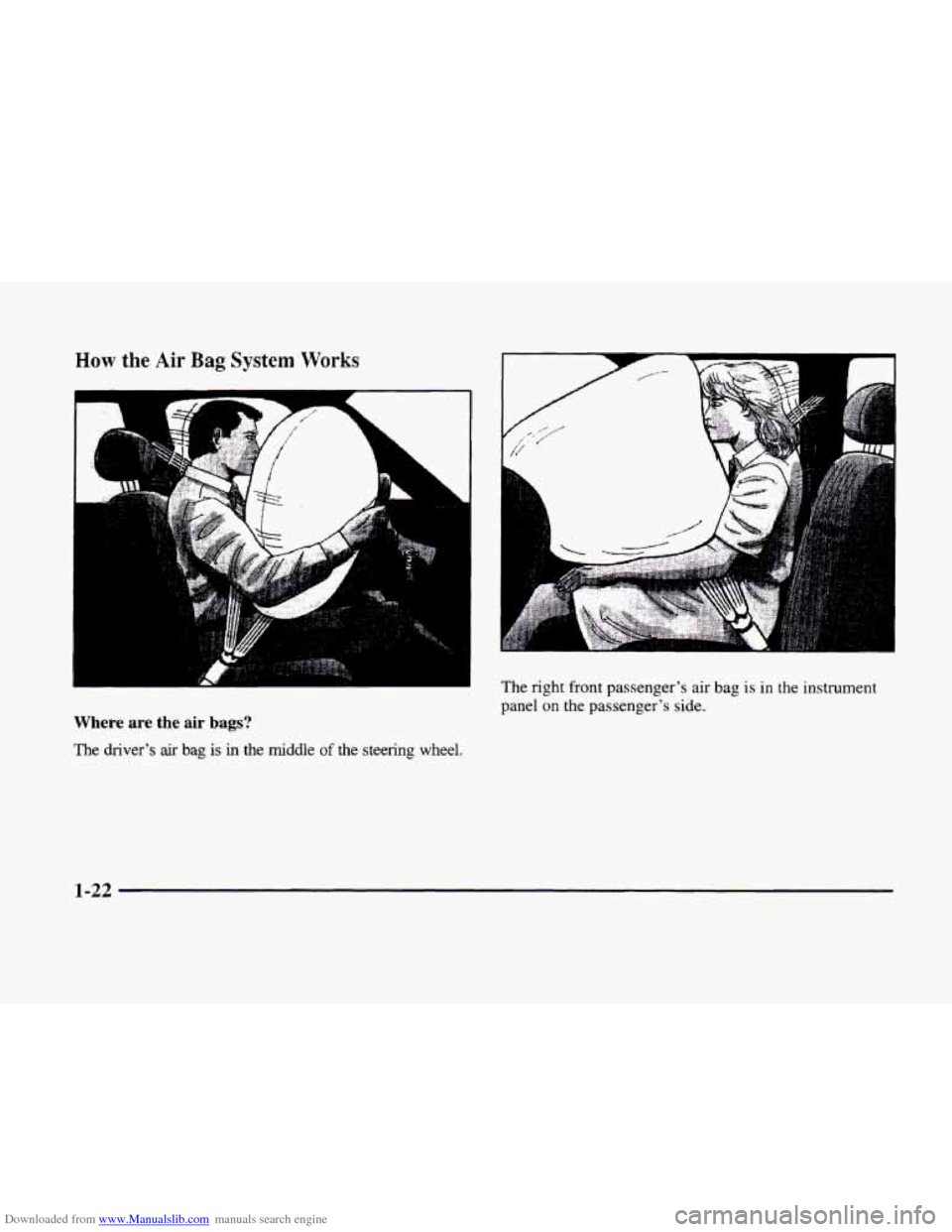
Downloaded from www.Manualslib.com manuals search engine HOW the Air Bag System Works
1
w.. ..
Where are the air bags?
The driver's air bag is in the middle of the steering wheel.
I
The right front passenger's air bag is in the instrument
panel
on the passenger's side.
1-22
Page 43 of 380
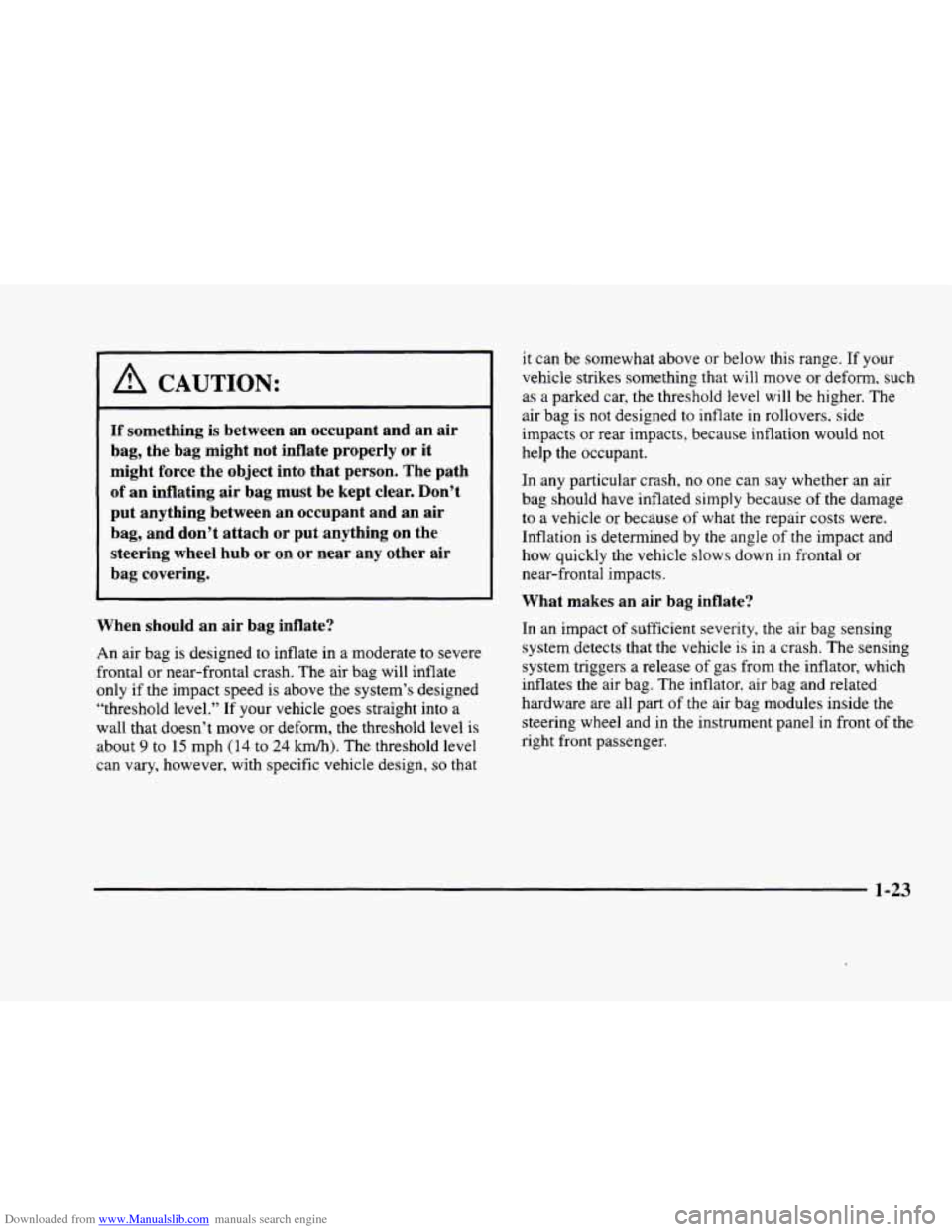
Downloaded from www.Manualslib.com manuals search engine 1 A CAUTION:
If something is between an occupant and an air
bag, the bag might not inflate properly
or it
might force the object into that person. The path
of an inflating air bag must be kept clear. Don’t
put anything between an occupant and an air
bag, and don’t attach
or put anything on the
steering wheel hub or
on or near any other air
bag covering.
~~
When should an air bag inflate?
An air bag is designed to inflate in a moderate to severe
frontal or near-frontal crash. The air bag will inflate
only if the impact speed
is above the system’s designed
“threshold level.” If your vehicle goes straight into a
wall that doesn’t move or deform, the threshold level is
about
9 to 15 mph (14 to 24 kmk). The threshold level
can vary, however, with specific vehicle design,
so that it can be
somewhat above or below this range. If your
vehicle strikes something that will move or deform, such
as a parked car, the threshold level will be higher. The
air bag is not designed to inflate in rollovers. side
impacts or rear impacts, because inflation would not
help the occupant.
In any particular crash, no one can say whether an air
bag should have inflated simply because of the damage
to a vehicle or because
of what the repair costs were.
Inflation is determined by the angle of the impact and
how quickly the vehicle slows down in frontal or
near-frontal impacts.
What makes an air bag inflate?
In an impact of sufficient severity, the air bag sensing
system detects that the vehicle is in a crash. The sensing
system triggers a release
of gas from the inflator, which
inflates the air bag. The inflator, air bag and related
hardware are all part of the air bag modules inside the
steering wheel and in the instrument panel in front
of the
right front passenger.
1-23
Page 44 of 380
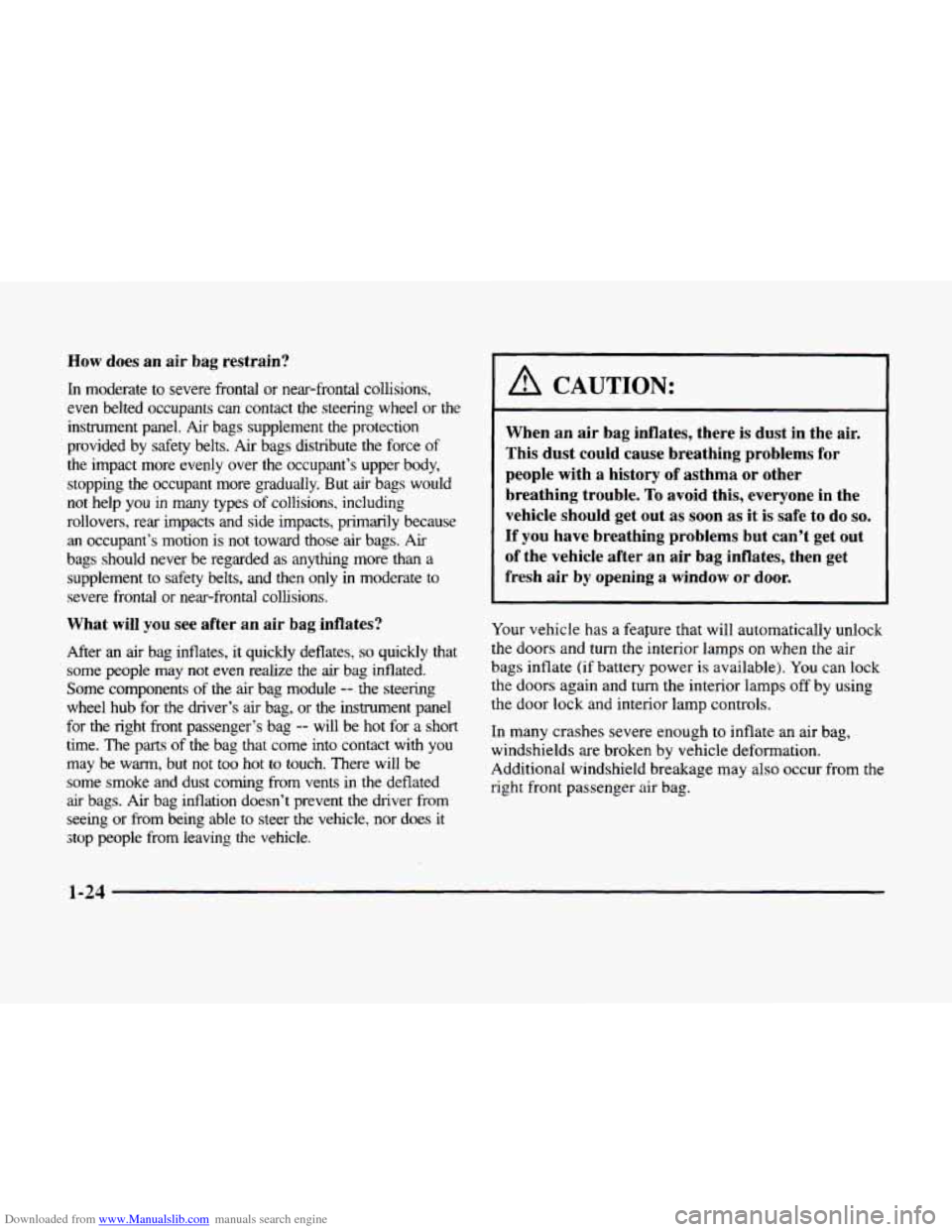
Downloaded from www.Manualslib.com manuals search engine How does an air bag restrain?
In moderate to severe frontal or near-frontal cobsions,
even belted occupants can contact the steering wheel or the
instrument panel.
Air bags supplement the protection
provided by safety belts. Air bags distribute the force
of
the impact more evenly over the occupant’s upper body,
stopping the occupant more gradually. But air bags
would
not help you in many types of collisions, including
rollovers, rear impacts and side impacts,
primarily because
an occupant’s motion is not toward those air bags. Air
bags should never be regarded as anything more than a
supplement to safety belts, and then
only in moderate to
severe frontal or near-frontal collisions.
What will you see after an air bag inflates?
After an air bag inflates, it quickly deflates, so quickly that
some people may not even realize the
air bag inflated.
Some components
of the air bag module -- the steering
wheel hub for the driver’s
air bag, or the instrument panel
for the right front passenger’s bag
-- will be hot for a short
time. The parts
of the bag that come into contact with you
may be warm, but not too
hot to touch. There will be
some smoke and dust coming from vents in the deflated
air bags. Air bag inflation doesn’t prevent the driver from
seeing
or from being able to steer the vehicle, nor does it
stop people from leaving the vehicle.
A CAUTION:
When an air bag inflates, there is dust in the air.
This dust could cause breathing problems
for
people with a history of asthma or other
breathing trouble. To avoid this, everyone in the
vehicle should get out as soon as it
is safe to do so.
If you have breathing problems but can’t get out
of the vehicle after an air bag inflates, then get
fresh air by opening a window or door.
Your vehicle has a feapre that will automatically unlock
the doors and turn the interior lamps on when the air
bags inflate (if battery power is available). You can lock
the doors again and turn the interior lamps off by using
the door lock and interior lamp controls.
In many crashes severe enough to inflate an air bag,
windshields are broken by vehicle deformation.
Additional windshield breakage may also occur from
the
right front passenger air bag.
1-24
Page 71 of 380

Downloaded from www.Manualslib.com manuals search engine Section 2 Features and Controls
Here you can learn about the many standard and optional features on your vehicle, and information on starting,
shifting and braking. Also explained are the instrument panel and the warning systems that tell you
if everything is
working properly
-- and what to do if you have a problem.
2-2
2-4
2-6
2-9
2- 13
2- 14
2-16
2- 17
2- 17
2-19
2-20
2-2
1
2-25
2-26
2-28
2-29 Keys
Door Locks
Remote Keyless Entry
(RKEj System
Trunk
Theft
Theft-Deterrent System (If Equipped)
PASS-Key(%
New Vehicle “Break-In”
Ignition Positions
Starting Your Engine
Engine Coolant Heater (If Equipped)
Automatic Transaxle Operation
Parking Brake
Shifting Into PARK (P)
Shifting Out of PARK (P)
Parking Over Things That
Burn
2-29
2-30
2-3 1
2-32
2-32
2-39
2-42
2-44
2-49
2-5
1
2-5 1
2-52
2-52
2-56
2-6
1
2-70
Engine Exhaust
Running
Your Engine While You‘re Parked
Windows
Tilt Wheel
Turn SignalMultifunction Lever
Exterior Lamps
Interior Lamps
Mirrors
Storage Compartments
Sun Visors
Cellular Telephone (Option)
Astroroof (Option)
Universal Transmitter (Option
j
Instrument Panel
Warning Lights, Gages and Indicators
Driver Information Center (DIC)
2-1
Page 79 of 380
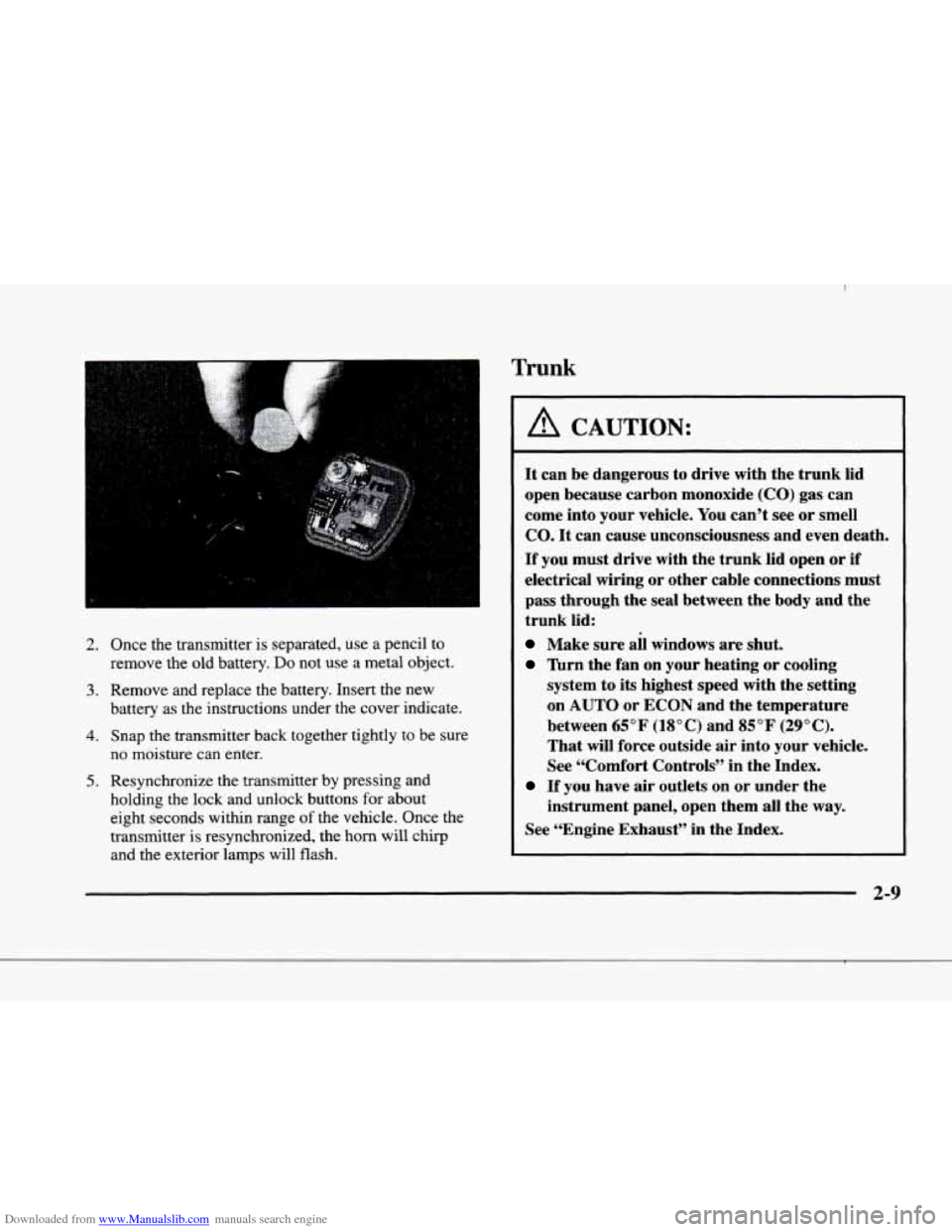
Downloaded from www.Manualslib.com manuals search engine d
r
?
!-
,i
b“
1 P
2. Once the transmitter is separated, use a pencil to
remove the old battery.
Do not use a metal object.
battery as the instructions under the cover indicate.
3. Remove and replace the battery. Insert the new
4. Snap the transmitter back together tightly to be sure
no moisture can enter.
5. Resynchronize the transmitter by pressing and
holding the lock and unlock buttons for about
eight seconds within range
of the vehicle. Once the
transmitter is resynchronized, the horn will chirp
and the exterior lamps will flash.
Trunk
A CAUTION:
It can be dangerous to drive with the trunk lid
open because carbon monoxide (CO) gas can
come into your vehicle. You can’t see or smell
CO. It can cause unconsciousness and even death.
If you must drive with the trunk lid open or if
electrical wiring or other cable connections must
pass through the seal between the body and the
trunk lid:
Make sure all windows are shut.
nrn the fan on your heating or cooling
system to its highest speed with the setting
on AUTO or ECON and the temperature
between
65°F (18°C) and 85°F (29°C).
That will force outside air into your vehicle.
See “Comfort Controls” in the Index.
If you have air outlets on or under the
instrument panel, open them all the
way.
See “Engine Exhaust” in the Index.
f9 2-9
Page 95 of 380
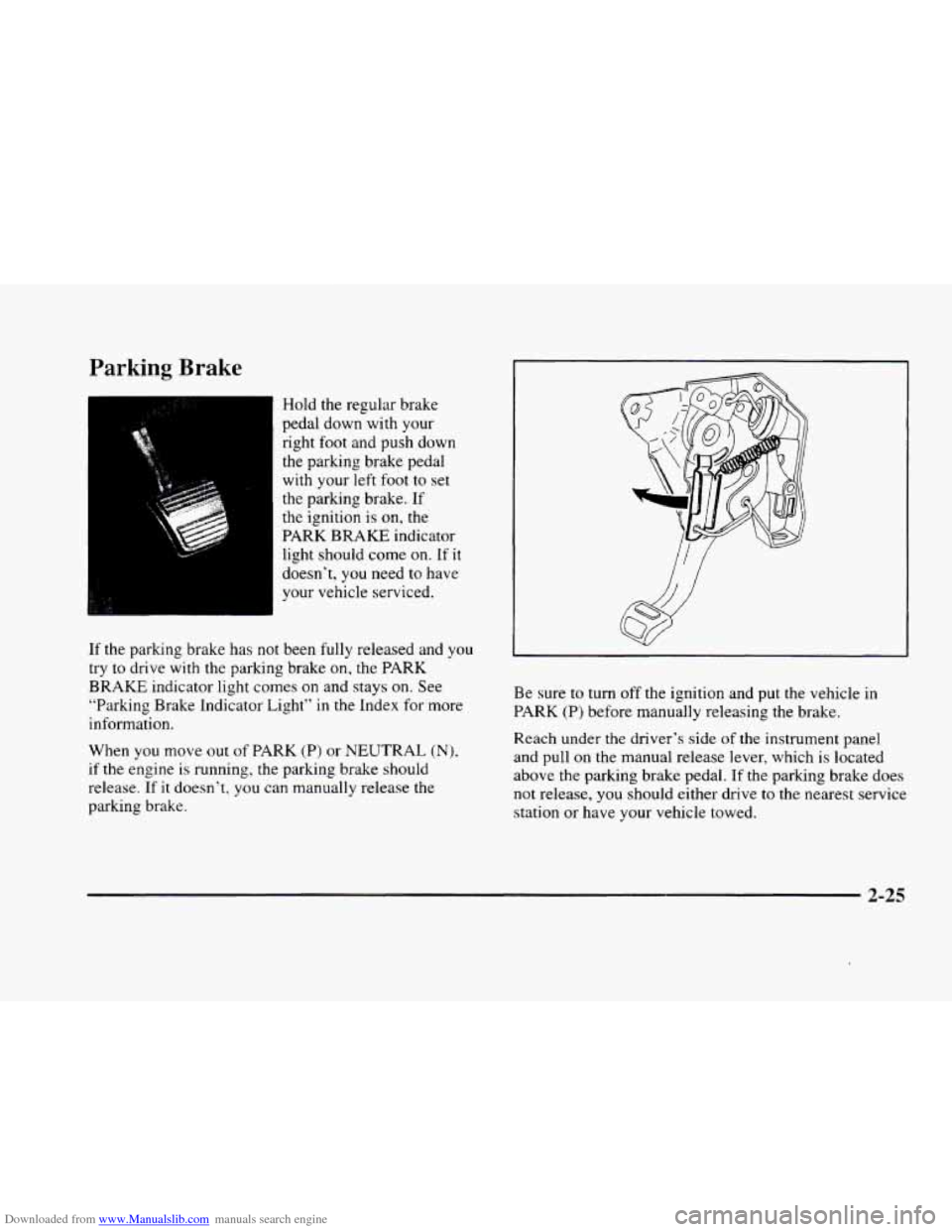
Downloaded from www.Manualslib.com manuals search engine Parking Brake
Hold the regular brake
pedal down with your
right
foot and push down
the parking brake pedal
with your left foot to set
the parking brake. If
the ignition is
on, the
PARK
BRAKE indicator
light should come
on. If it
doesn’t, you need to have
your vehicle serviced.
If the parking brake has not been fully released and you
try to drive with the parking brake
on, the PARK
BRAKE indicator light comes on and stays on. See
“Parking Brake Indicator Light“ in the Index for more
information.
When you move out of PARK
(P) or NEUTRAL (N),
if the engine is running, the parking brake should
release. If
it doesn’t, you can manually release the
parking brake. Be
sure
to turn off the ignition and put the vehicle in
PARK (P) before manually releasing the brake.
Reach under
the driver’s side of the instrument panel
and pull
on the manual release lever, which is located
above the parking brake pedal. If the parking brake does
not release, you should either drive
to the nearest service
station or have your vehicle towed.
2-25